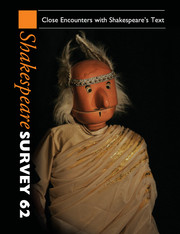Book contents
- Frontmatter
- Shakespeare, text and paratext
- The popularity of Shakespeare in print
- The continuing importance of new Bibliographical method
- ‘Honour the real thing’: Shakespeare, Trauma and Titus Andronicus in South Africa
- ‘O, these encounterers’: on Shakespeare’s meetings and partings
- A play of modals: Grammar and potential action in early Shakespeare
- Merry, marry, Mary: Shakespearian wordplay and Twelfth Night
- A subtle point: Sleeves, tents and ‘Ariachne’s broken woof’ (again)
- The look of Othello
- Red button Shakespeare
- ‘Mark you / his absolute shall?’: Multitudinous tongues and contested words in Coriolanus
- Chagall’s Tempest: An autobiographical reading
- Reading illustrated editions: Methodology and the limits of interpretation
- Close encounters with Anne Brontë's Shakespeare
- Shakespeare and the magic lantern
- Shakespeare and the coconuts: close encounters in post-apartheid South Africa
- The Schrödinger effect: Reading and misreading performance
- Behind the scenes
- Inner monologues: Realist acting and/as Shakespearian performance text
- More japanized, casual and transgender shakespeares
- Translation futures: Shakespearians and the foreign text
- After translation
- ‘The single and peculiar life’: Hamlet’s heart and the early modern subject
- Mapping King Lear
- ‘Last on the stage’: The place of Shakespeare in Charles Darwin’s ethology
- Sense/memory/sense-memory: Reading narratives of Shakespearian rehearsals
- Shakespeare performances in England (and Wales), 2008
- Professional Shakespeare productions in the British Isles, January–December 2007
- The Year's Contributions to Shakespearian Study 1 Critical Studies
- 2 Shakespeare in performance
- 3a Editions and textual studies
- 3b Editions and textual studies
- Index to Volume 62
The Schrödinger effect: Reading and misreading performance
Published online by Cambridge University Press: 28 November 2009
- Frontmatter
- Shakespeare, text and paratext
- The popularity of Shakespeare in print
- The continuing importance of new Bibliographical method
- ‘Honour the real thing’: Shakespeare, Trauma and Titus Andronicus in South Africa
- ‘O, these encounterers’: on Shakespeare’s meetings and partings
- A play of modals: Grammar and potential action in early Shakespeare
- Merry, marry, Mary: Shakespearian wordplay and Twelfth Night
- A subtle point: Sleeves, tents and ‘Ariachne’s broken woof’ (again)
- The look of Othello
- Red button Shakespeare
- ‘Mark you / his absolute shall?’: Multitudinous tongues and contested words in Coriolanus
- Chagall’s Tempest: An autobiographical reading
- Reading illustrated editions: Methodology and the limits of interpretation
- Close encounters with Anne Brontë's Shakespeare
- Shakespeare and the magic lantern
- Shakespeare and the coconuts: close encounters in post-apartheid South Africa
- The Schrödinger effect: Reading and misreading performance
- Behind the scenes
- Inner monologues: Realist acting and/as Shakespearian performance text
- More japanized, casual and transgender shakespeares
- Translation futures: Shakespearians and the foreign text
- After translation
- ‘The single and peculiar life’: Hamlet’s heart and the early modern subject
- Mapping King Lear
- ‘Last on the stage’: The place of Shakespeare in Charles Darwin’s ethology
- Sense/memory/sense-memory: Reading narratives of Shakespearian rehearsals
- Shakespeare performances in England (and Wales), 2008
- Professional Shakespeare productions in the British Isles, January–December 2007
- The Year's Contributions to Shakespearian Study 1 Critical Studies
- 2 Shakespeare in performance
- 3a Editions and textual studies
- 3b Editions and textual studies
- Index to Volume 62
Summary
The fixture of her eye has motion in't, As we are mock'd with art.
(The Winter's Tale, 5.3.67-8)It is, perhaps, to be expected that professional academic Shakespearians often make for cynical and jaded theatre audiences. They have, after all, seen it all before, if only in their heads. But alongside the bored response to what is familiar there is often something closer to indignation, a frustrated outrage - oft overheard in the intermission bar - about the extent to which the production is 'wrong'. Recent RSC offerings are a case in point. I thoroughly enjoyed the 2008 Hamlet (dir. Doran) and loathed the Shrew in the same season (dir. Morrison), but found some of my academic colleagues defended their likes and dislikes about the shows - in admittedly informal and spontaneous conversation - solely in terms of how they read the plays as text. Some objected to portions cut from the Hamlet script, others to the invasive nature of theatrical visuals (why isn't Hamlet wearing shoes?). I hated the Shrew production, it was alleged, because I misrecognized the play's unrelenting misogyny. Yes, this production was less romantic, less fun, than many others, but it got the play right. Now, I would argue that I hated that production not because of its conceptual approach, but because I found it tedious and unfunny despite the fact that it was trying hard - excruciatingly hard, in fact - to be the opposite. What I faulted the production for was a crassness of approach (as was the case with Morrison’s Macbeth the previous year) coupled with woeful execution, and while I might be persuaded that this is in some way interesting I can’t be persuaded that such failings are eradicated by the production’s derivation from a particular reading of the play.
- Type
- Chapter
- Information
- Shakespeare Survey , pp. 222 - 235Publisher: Cambridge University PressPrint publication year: 2009
- 1
- Cited by

